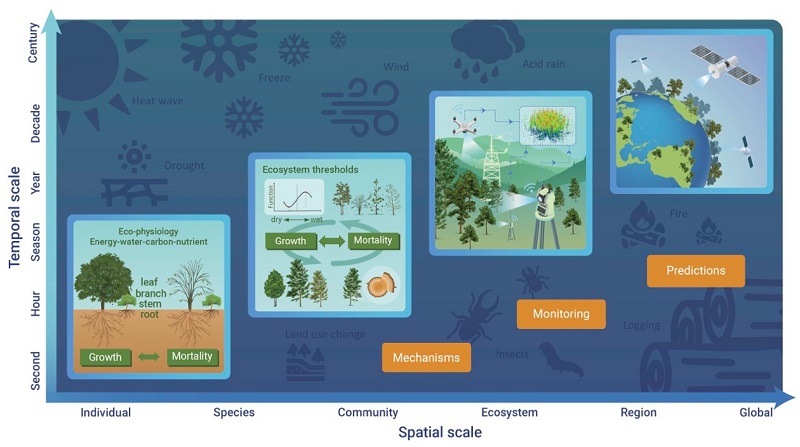Forests are the largest carbon sinks among terrestrial ecosystems, mainly sequestrate carbon through tree growth, playing an important role in mitigating climate change. A recent study in Nature has found that the reduction of carbon sinks in Amazon forests is caused by drought-induced tree mortality, which in turn leads to a decrease in forest biomass. A key trait, plant xylem hydraulic safety margin, can be used to predict the risk of tree mortality and carbon loss under drought. However, other global change processes also have profound impacts on forest carbon sinks, with significant differences in trends and strengths of these impacts. Therefore, it is urgent to construct a research framework that evaluates the impact of global change on forest trees at multiple spatial-temporal scales to explore the response and adaptation mechanisms of forest carbon sinks to global change.
Dr. Hui Liu, an associate professor from South China Botanical Garden, Chinese Academy of Sciences, and scientists in the field of forest community, ecosystem, and remote sensing research, discussed the leading factors and research trends of carbon sink research: 1) At the individual and species scales: Plant functional traits can bridge the gap carbon sink and climate change based on eco-physiological mechanisms. In the future, it is necessary to accurately select functional traits for predicting forest biomass based on the key limiting factors in forest growth-mortality trade-off; 2) At the community scale: long-term monitoring of species components and community structures, combined with tree ring research, has always been the basis for clarifying the dynamic driving factors of forest carbon sequestration; 3) At the ecosystem scale: the growth-mortality trade-off is closely related to the ecosystem resilience and resistance, but the determination of environmental thresholds for ecosystem carbon sink is more complex and difficult, requiring simultaneous consideration of dynamic thresholds and new equilibrium states; 4) At the regional and global scales: the combination of multi-temporal, broad-scale remote sensing imagery with fine-resolution LiDAR (above ground) and ground penetrating radar (underground) data can upscale regional monitoring data to the global level, achieving near global coverage of surface changes and carbon dynamics for decades. With the rapid accumulation and development of eco-physiology, community and ecosystem ecology, remote sensing, new algorithms, and process models, the estimation and prediction of forest biomass can be significantly improved (Figure 1).
This work has been published in The Innovation (https://doi.org/10.1016/j.xinn.2023.100463). Dr. Hui Liu is the first author, co-authors include Dr. Lin Zhang from Institute of Tibetan Plateau Research, Chinese Academy of Sciences; Dr. Qin Ma from Nanjing Normal University; Dr. Wei Zhao from Institute of Geographic Sciences and Natural Resources Research, Chinese Academy of Sciences; and Dr. Yiping Chen from Sun Yat-Sen University. In the current situation of intensified global change and increased frequency of extreme climate events, this study provides a framework for comprehensive monitoring and modeling, as well as the application of new technologies to accurately evaluate and predict forest carbon sinks.
